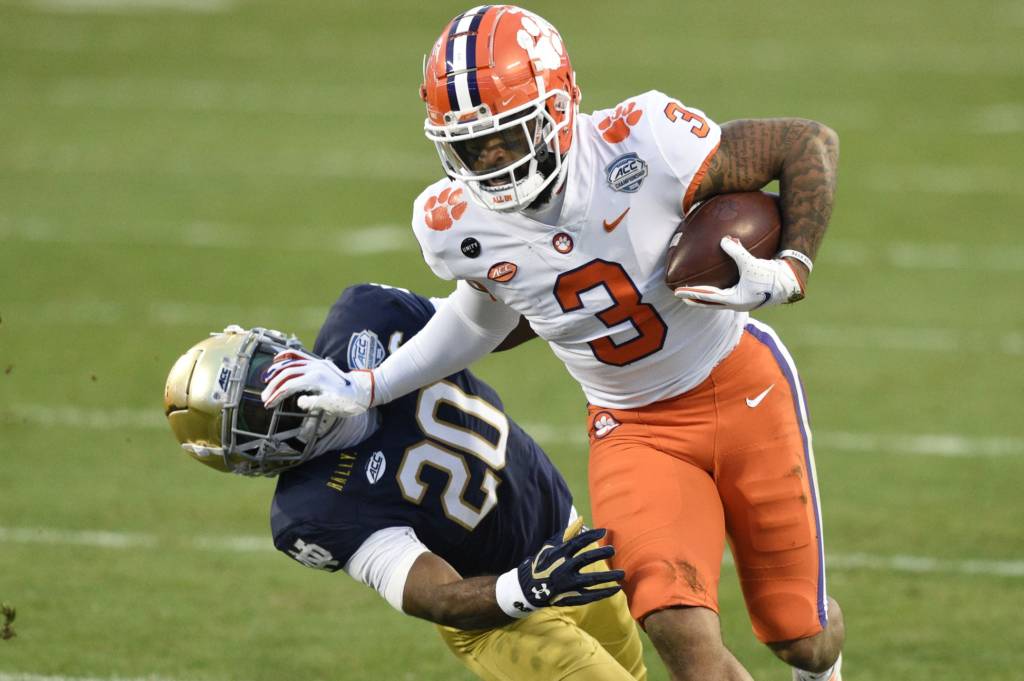In an interview with former wide receiver Brandon Marshall, Amari Rodgers said his dream scenario was going to the Green Bay Packers in the second round of this year’s draft. The Packers have lacked a true slot receiver since they lost Randall Cobb after the 2018 season, and Rodgers hopes he can add that dimension back to their offense.
At Clemson’s pro day, when asked about how he compared to the former Packer, Rodgers told reporters, “I definitely see myself as a Randall Cobb-type of player being used in the slot, jet sweeps, and the return game as well.”
Packers general manager Brian Gutekunst agreed. “He fills so many holes for us,” Gutekunst said at his post-draft press conference. “That’s one of the reasons we traded up for him. Not only as a punt returner and slot receiver but as you guys have seen over the past few years, the creativity that Matt [LaFleur] has within his offense, some of the jet sweeps, and screens.
“He’s a 212-pound receiver. He’s not one of these smaller guys. So I think kick returning could be part of his arsenal as well. He’s just built for us up here in Green Bay. Very versatile player. Very smart player.”
So, how exactly do Rodgers and Cobb compare?
For starters, while Rodgers is around 25 pounds heavier than Cobb, they both posted very similar pre-draft testing numbers. Cobb clocked a 4.46 40-yard dash back in 2011, while Rodgers ran a 4.45 40-yard dash at the Clemson pro day in March. Furthermore, Cobb is 5-foot-10, 192 lbs. Rodgers measures at 5-foot-9, 212 lbs. Finally, both receivers also logged identical vertical jumps at 33.5 inches. Athletically the comparisons between the two are strikingly similar.
The comparisons don’t stop there, though. Both Rodgers and Cobb are best in the slot.
Eighty-two percent of Rodgers’ snaps last season came in the slot, where he showcased consistent footwork, reliable hands, and sharp change-of-direction skills, and release. Over his entire Packers career, around 82 percent of Cobb’s snaps were in the slot, coincidentally identical to Rodgers’ snap distribution at Clemson.
The Packers have operated the last couple of seasons without a slot receiver, with only 31 percent of Aaron Rodgers’ passes going toward the slot receivers.
Amari Rodgers is aware of this. “Ever since Randall left, they haven’t had a guy like that,” he said. “Just being able to bring my game to that offense, it would be special just to see me work with a well-known player like Davante Adams.”
Rodgers may not have long arms or be a “burner,” but he can still make an impact down the field.
Not only is Rodgers a reliable slot weapon, but he can also add to the Packers’ return game, which has been a source of instability for a few seasons now. Last year they had returners Tyler Ervin and Tavon Austin take back eight kicks for a net total of 34 yards.
Rodgers has dynamic run-after-the-catch ability and was one of the best at making defenders miss.
“I’m very comfortable in the return game,” Rodgers said, especially punt returns. “That’s my bread and butter.”
He is the complete wide receiver, despite some physical drawbacks, and can add immediate production and an upgrade to the Packers’ slot receiver position.
“His pedigree, his performance in college at a big-time stage were things that comforted us,” said Gutekunst at his post-draft press conference, “and [had us] feeling like he could step in and be a productive player for us early in his career.”
Similar physical tools are a start to the comparison. But beyond that, Rodgers adds the same elements that Cobb took with him when he left Green Bay a mere three years ago: route running, quickness, and release.
Now, the Packers get those elements back.

